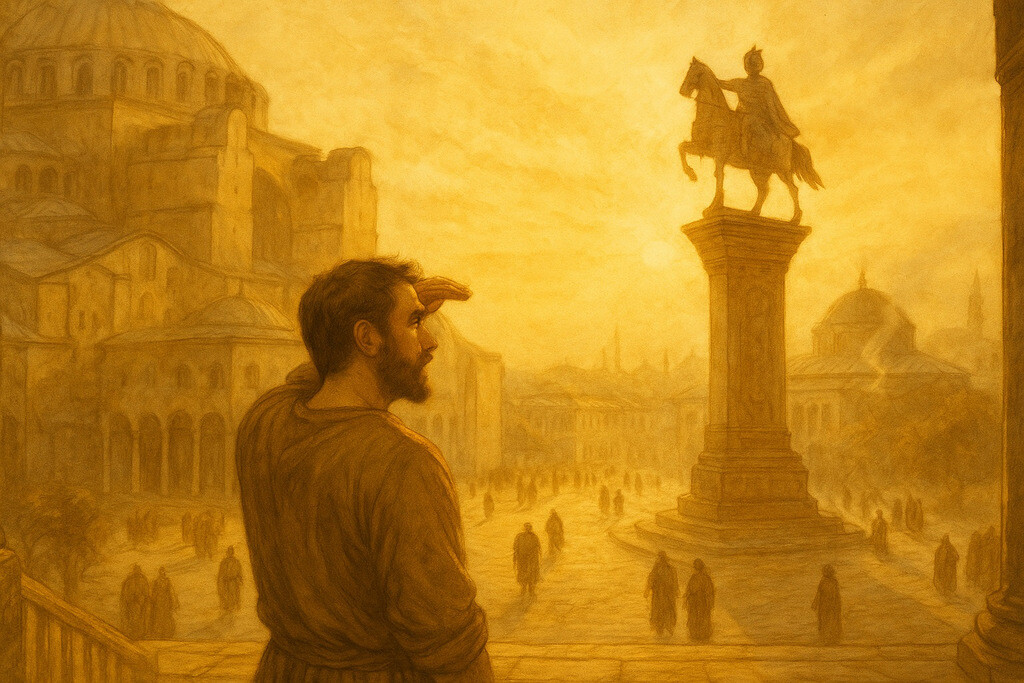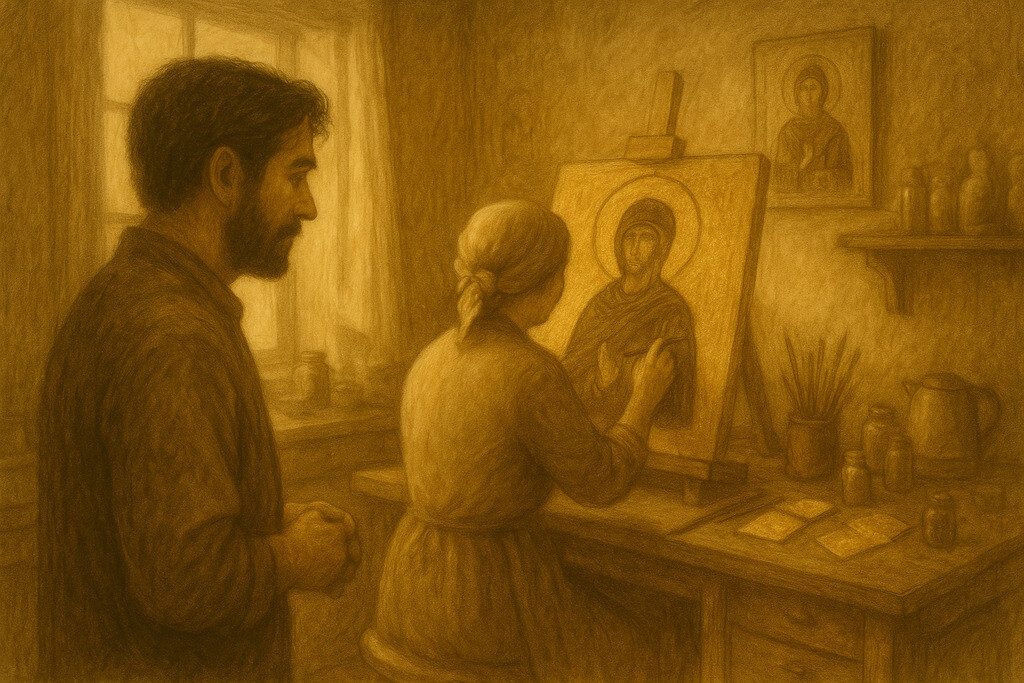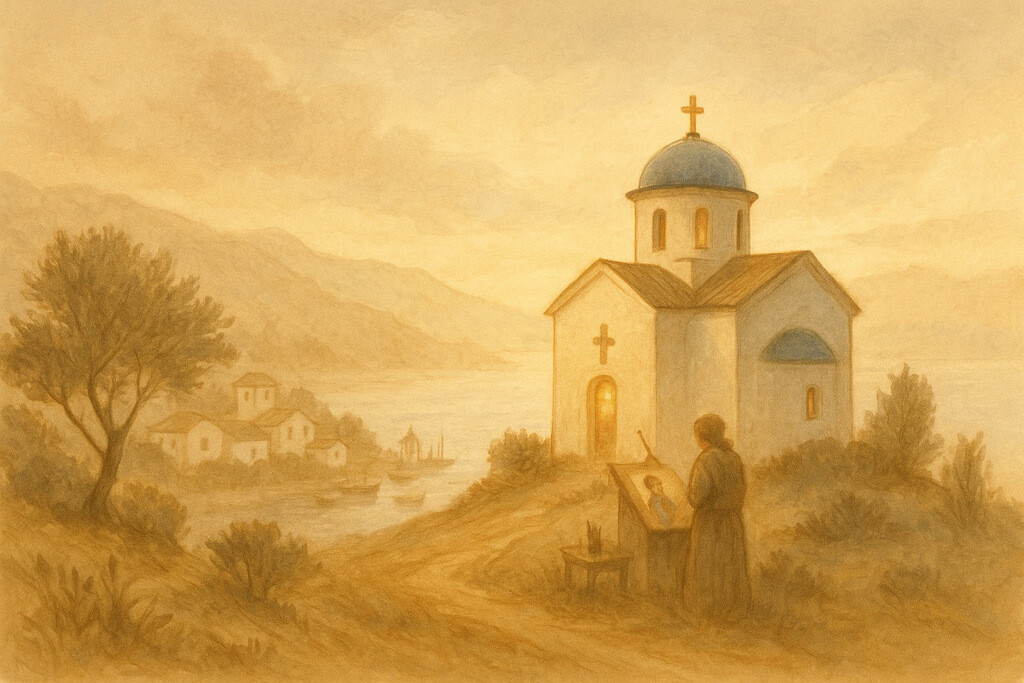Answers to the most common questions about the project, the characters, and the creative vision behind the dream.
About the Project

What is Byzantine Stories?
Byzantine Stories is a literary project where history and imagination meet.
Created by Istanbul-based guide and writer Serhat Engul, it explores how the lost world of Byzantium can still breathe through modern consciousness.
Each story follows Stavros, a New York–based designer who dreams himself into the Byzantine past — where emperors, saints, and artists speak again through light and memory.
Why was this project created?
After two decades of guiding travelers through Istanbul’s Byzantine heritage, Serhat realized that history often felt static — like something locked behind glass.
He wanted to make it alive again.
Byzantine Stories began as an experiment: what happens when real historical knowledge merges with dreamlike storytelling and AI-assisted imagination?
The result is a series of introspective tales where history becomes personal and time becomes fluid.
Is it based on real Byzantine history?
Yes — each episode draws from authentic Byzantine events, places, and traditions.
But the stories are not historical reconstructions.
They are reimaginings, blending factual research with poetic interpretation.
As the site’s motto says:
“These are not stories about Byzantium — they are Byzantium dreaming of itself.”
About the Characters

Who is Stavros?
Stavros is a modern graphic designer living in New York.
Through his dreams, he begins to cross the boundaries of time and encounter the echoes of Byzantine life.
He represents the modern human searching for meaning in forgotten worlds — a bridge between memory and imagination.
Who are Anna and Eleni?
Anna is Stavros’s partner in New York — rational, loving, yet quietly unsettled by the growing pull of his dreams.
Eleni is his mother, an icon painter whose art becomes the key that unlocks Stavros’s connection to Byzantium.
Where Anna represents the modern world’s clarity, Eleni embodies the mystical continuity of tradition.
Who were Georgios, Manolis, and Nikolaos?
They are Stavros’s paternal ancestors — a family line shaped by exile, migration, and silence.
Georgios fled the fire.
Manolis crossed the sea.
Nikolaos inherited their silence.
Through them, the story connects modern identity to the long shadow of history.
Do the dreams follow real Byzantine events?
Each dream corresponds to a distinct layer of Byzantine history:
- Episode I – The Battle of Pliska (811 CE): War and memory.
- Episode II – The Mosaic of Time: Art and divine light.
- Episode III – The Procession of Hodegetria: Faith, ancestry, and illumination.
Together they form a trilogy — from conflict to creation to revelation.
About the Locations

Where does the story take place in the real world?
The narrative unfolds across two main locations — one real, one imagined:
Astoria, New York City
Stavros’s home and creative world. Astoria has long been the heart of the Greek diaspora in New York — a place where old songs, church processions, and fragments of lost homelands still linger.
In Byzantine Stories, Astoria represents the modern Greek spirit living far from its roots yet still illuminated by them.
Nea Byzantion, California (Fictional)
A hidden Greek settlement on the Pacific coast near Monterey.
Though imaginary, it echoes the utopian idea of a “New Byzantium” — a sanctuary where art, memory, and faith might coexist in peace.
Nea Byzantion is both a real-world metaphor and a dream geography: the West Coast’s light becomes the mirror of Constantinople’s gold.
Why these places?
Both locations reflect the dual nature of Stavros’s journey:
- Astoria anchors him in reality, family, and heritage.
- Nea Byzantion represents rebirth, idealism, and the timeless quest for beauty.
Together, they trace Byzantium’s invisible map across continents — from the Bosphorus to the Atlantic, from memory to imagination.
About the Creation Process

Was AI used in writing these stories?
Yes — but not in the way you might think.
AI did not replace the author; it collaborated with him.
As Serhat describes it:
“AI gave voice to the sentences I had always imagined but never dared to write.”
Every episode was conceived, edited, and refined through a dialogue between human vision and machine language.
Who creates the visuals?
The visuals are AI-assisted, human-directed illustrations designed in a painterly, atmospheric style.
Each image is composed to echo the tone of the story — soft light, gold dust, candle smoke, and the quiet gravity of Byzantine art.
Can I quote or share these stories?
Yes, you may quote short excerpts or share links as long as proper credit is given:
ByzantineStories.com – Stories and visuals by Serhat Engul.
For academic or media use, please include a direct link to the relevant episode page.
Closing Note
“Byzantine Stories is more than fiction — it is a bridge between the living and the remembered.”